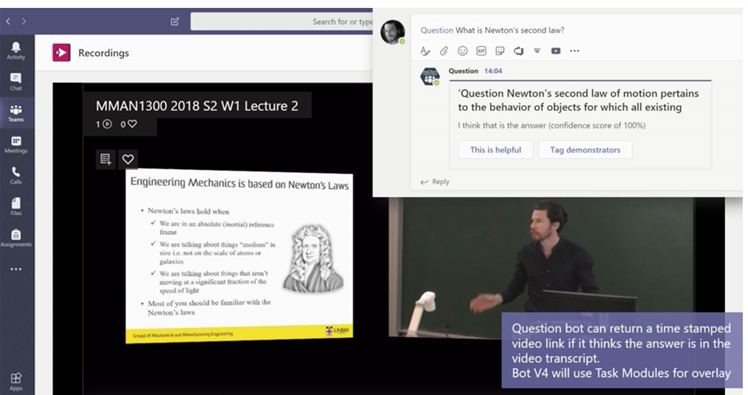A UNSW pilot of Microsoft Teams as a virtual classroom for engineering students has been beefed up with a bot that helps students out with answers when they get stuck in their studies.

The Sydney-based university started piloting Microsoft Teams in early 2018 as a way to give students that attended courses virtually an experience akin to in-person attendance on campus.
Dr. David Kellermann from the Faculty of Engineering said at the time he “saw a disparity between the learning experiences of students who attended his lectures in person and those who, due to limited seating in the lecture theater, accessed online recordings of his lectures”.
He felt the online cohort missed out on the full lecture experience - “the use of visual aids and nonverbal communication, not to mention the opportunity to raise questions and participate in class discussions.”
So he created an online space in Teams where all his students could equally participate.
Speaking at Microsoft’s Build 2019 conference in Seattle last month, Kellermann said the experiment had since scaled up from 370 to 1200 students.
“My first year engineering course is about 600 students, my second year engineering course is about the same, and so essentially I’m the manager of a huge number of people,” he said.
“Within the delivery of an engineering subject we have video, digital ink from all of the problems we’ve done together, lab results with Excel spreadsheets, we have Word and PPT documents, and we’ve got a whole series of different resources - assignment submissions, collaborative spaces, forums and different things we’re using essentially to work together as a huge team of 600 people.”
Kellermann said he wanted to improve the experience in Teams by deploying a bot and app in the environment to help answer students’ questions faster and smarter.
The result is the Question bot and app, built in eight weeks and now used by 95 percent of students in courses that Kellermann teaches.
“The idea of Question bot is when you ask a question, you write ‘I have an @Question about this’ and you tag it,” he said.
“What happens next with the bot is if someone does ask a question it’s essentially flagged as a to-do list. So ... I treat my student questions as service tickets.
“It’s something that needs to be answered and it’s really important because when you have 600 students, the Teams channel is like a firehose. You could ask a question and an hour later it’s a metre off the screen.”
The bot compiles questions and answers into a “quick reference Q&A page” that students can visit. If they are interested, clicking on an individual Q&A will take them back to the original thread in Teams.
“What this does is it re-engages people with valuable conversation that’s happened,” Kellermann said.
“So the idea is we’re leveraging assets, conversation assets.”
Question bot is also able to answer questions directly in the firehose if it can draw upon existing material to do so.
“You set a threshold for how rigorous or aggressive you want the bot to answer, and sure enough after a couple of weeks my bot started to answer questions on its own,” Kellermann said.
“So complex questions that my students were asking, if a colleague of theirs had asked it maybe a couple of weeks ago and it was buried in the forum, instantaneously the bot will return that answer again.”
Courtesy of computer vision run on Azure, the bot can also answer and log questions contained in images uploaded to Teams by students.
“In engineering, because we do so much calculation, students will just take a photo of the work they’re doing, and if a student asks a question [from a photo] like, ‘Hey I’m stuck on this, can anybody help me?’, that’s not useful to add to a knowledge base because all of the context is within the photograph,” Kellermann said.
“What I started doing was I put QR codes onto all of the material to do with my courses - assignments, questions, everything. And whenever a student takes a photo of it, the bot is able to read that QR code and reply straight away.
“That allows it to directly address the particular content and to log the information”.
Additionally, Kellermann records his lectures as video files and offers transcriptions in Teams. Question bot can poll those transcripts for answers and then direct students to the exact point in the recorded lecture to get the information they’re requesting.
“If a student asks a question like ‘does anybody know what inertial bodies are’, the bot will search the transcripts and if it thinks it’s got an answer within the video, it will return a timestamped video link within the forum,” he said.
“[It’s] a great way to leverage existing assets we have.”



_(20).jpg&h=140&w=231&c=1&s=0)





_(26).jpg&w=100&c=1&s=0)

 iTnews Executive Retreat - Security Leaders Edition
iTnews Executive Retreat - Security Leaders Edition











_(1).jpg&h=140&w=231&c=1&s=0)



